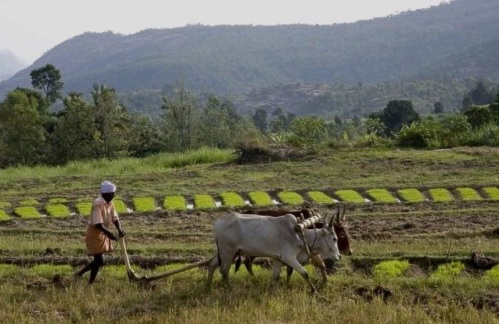
- Agriculture in India is more than an economic activity — it is a way of life.
- It employs over 45% of the Indian workforce, and contributes approximately 18.2% to the Gross Value Added (GVA) as of 2022-23, as per NSO estimates.
- However, the sector is at a critical juncture, facing technological disruptions, climate-related challenges, and market inefficiencies.
- To make Indian agriculture future-ready, there is a pressing need for reform, innovation, and investment.
Current Scenario: Key Facts
- GVA Contribution (2024–25): 16%
- Agricultural workforce: Over 45% of India’s population
- Land holdings: 86% of farmers are small and marginal (less than 2 hectares)
- Irrigation dependence: ~51% of the net sown area is still rain-fed
- Decline in crop sub-sector: From 62.4% (2011–12) to 54.3% (2022–23)
Major Challenges in Indian Agriculture
Low Mechanization
- Only 47% of Indian agriculture is mechanized.
- In contrast, China (60%), Brazil (75%) have adopted extensive mechanization.
- Result: Low productivity, high labour dependency, and cost inefficiencies.
Inadequate Irrigation Infrastructure
- Over half of agricultural land relies on monsoons.
- Erratic rainfall due to climate change has led to frequent droughts and floods, impacting yield.
Low Investment in R&D
- India invests just 0.4% of Agricultural GDP in R&D, compared to:
- Israel: 4.3%
- China: 1.5%
- This affects the development and dissemination of new, climate-resilient technologies.
Cobweb Phenomenon & Price Volatility
- Farmers often suffer due to market mismatches.
- Overproduction → Price crash → Losses → Underproduction next season → Price hike (cycle continues)
- Reasons: Inefficient storage, weak market linkages, lack of real-time price information.
Fragmented Land Holdings
- Makes modern technology adoption and economies of scale difficult.
Limited Access to Credit
- Many small farmers rely on informal credit sources with high interest rates due to limited financial inclusion.
Government Interventions and Schemes
Seven Key Agricultural Missions (2023–24)
|
Initiative
|
Objective
|
|
Mission on Horticulture
|
Boost high-value crops
|
|
Digital Agriculture Mission
|
Promote data-driven and smart farming
|
|
Livestock Health Mission
|
Improve animal health and productivity
|
|
Strengthening Krishi Vigyan Kendras (KVKs)
|
Disseminate innovations to the grassroots
|
|
Crop Science Mission
|
Enhance food and nutrition security
|
|
Agricultural Education and Management
|
Build skilled human capital
|
|
Natural Resource Management
|
Sustainable use of land, water, and soil
|
PM-KISAN
- ₹6,000 annual income support to small/marginal farmers through Direct Benefit Transfer (DBT).
e-NAM (National Agricultural Market)
- A unified digital platform connecting 1,000+ APMC mandis for transparent trading.
PM Fasal Bima Yojana (Crop Insurance)
- Offers affordable insurance against crop loss due to natural calamities.
JAM Trinity (Jan Dhan–Aadhaar–Mobile)
- Enhances financial inclusion, subsidy delivery, and farmer authentication.
Role of Technology: AI, Automation, and Smart Farming
- Artificial Intelligence (AI) is replacing traditional white-collar roles, even in agriculture:
- Automated crop monitoring
- Predictive weather analysis
- Drone-based pesticide spraying
- AI can improve productivity but may also reduce labour-intensive jobs, requiring re-skilling.
- Examples:
- Google’s AI tools automate code and processes — similar tools now entering AgriTech.
- FarmERP, DeHaat, CropIn – Indian agri-startups using AI and big data.
Policy Recommendations: The Way Forward
|
Sector
|
Policy Suggestion
|
|
Skill Development
|
Focus on AI, data analytics, robotics for agriculture
|
|
Credit Access
|
Expand Kisan Credit Cards (KCC) to tenant and landless farmers
|
|
Market Reforms
|
Amend APMC Acts, encourage private markets
|
|
Irrigation
|
Promote Micro-irrigation and Watershed Management
|
|
Agri-Education
|
Integrate entrepreneurship and digital skills in school curricula
|
|
Technology Adoption
|
Incentivize precision farming, drone use, and e-agriculture tools
|



